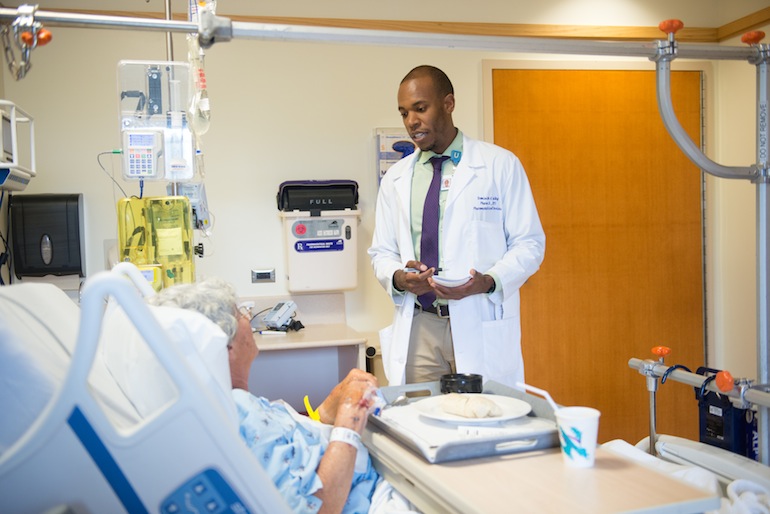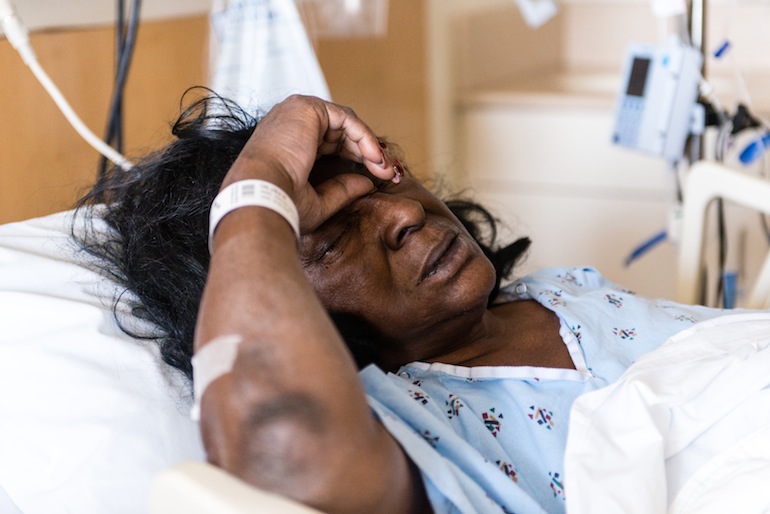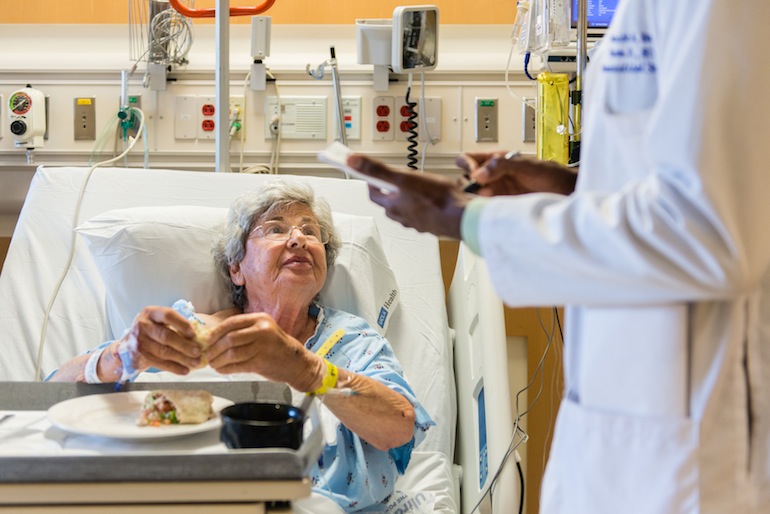SANTA MONICA, Calif. — Dominick Bailey sat at his computer, scrutinizing the medication lists of patients in the geriatric unit.
A doctor had prescribed blood pressure medication for a 99-year-old woman at a dose that could cause her to faint or fall. An 84-year-old woman hospitalized for knee surgery was taking several drugs that were not meant for older patients because of their severe potential side effects.
And then there was 74-year-old Lola Cal. She had a long history of health problems, including high blood pressure and respiratory disease. She was in the hospital with pneumonia and had difficulty breathing. Her medical records showed she was on 36 medications.
“This is actually a little bit alarming,” Bailey said.
He was concerned about the sheer number of drugs, but even more worried that several of them — including ones to treat insomnia and pain — could suppress Cal’s breathing.
An increasing number of elderly patients nationwide are on multiple medications to treat chronic diseases, raising their chances of dangerous drug interactions and serious side effects. Often the drugs are prescribed by different specialists who don’t communicate with each other. If those patients are hospitalized, doctors making the rounds add to the list — and some of the drugs they prescribe may be unnecessary or unsuitable.
“This is America’s other drug problem — polypharmacy,” said Dr. Maristela Garcia, director of the inpatient geriatric unit at UCLA Medical Center in Santa Monica. “And the problem is huge.”
The medical center, where Bailey also works, is intended specifically for treating older people. One of its goals is to ensure that elderly patients are not harmed by drugs meant to heal them.
That work falls largely to Bailey, a clinical pharmacist specializing in geriatric care.
Some drugs can cause confusion, falling, excessive bleeding, low blood pressure and respiratory complications in older patients, according to research and experts.
Older adults account for about 35 percent of all hospital stays but more than half of the visits that are marred by drug-related complications, according to a 2014 action plan by the U.S. Department of Health and Human Services. Such complications add about three days to the average stay, the agency said.
Data on financial losses linked to medication problems among elderly hospital patients is limited. But the Institute of Medicine determined in 2006 that at least 400,000 preventable “adverse drug events” occur each year in American hospitals. Such events, which can result from the wrong prescription or the wrong dosage, push health care costs up annually by about $3.5 billion (in 2006 dollars).
And even if a drug doesn’t cause an adverse reaction, that doesn’t mean the patient necessarily needs it. A study of Veterans Affairs hospitals showed that 44 percent of frail elderly patients were given at least one unnecessary drug at discharge.
“There are a lot of souvenirs from being in the hospital: medicines they may not need,” said David Reuben, chief of the geriatrics division at UCLA School of Medicine.
Some drugs prescribed in the hospital are intended to treat the acute illnesses for which the patients were admitted; others are to prevent problems such as nausea or blood clots. Still others are meant to control side effects of the original medications.

Pharmacist Dominick Bailey goes over Harriet Diamond’s medications. Diamond, 84, was hospitalized in the geriatric unit for knee surgery. (Heidi de Marco/KHN)
University of California, San Francisco researcher and physician Ken Covinsky, said many doctors who prescribe drugs in hospitals don’t consider how long those medications might be needed. “There’s a tendency in medicine every time we start a medicine to never stop it,” Covinsky said.
When doctors in the hospital change or add to the list of medications, patients often return home uncertain about what to take. If patients have dementia or are unclear about their medications, and they don’t have a family member or a caregiver to help, the consequences can be disastrous.
One 2013 study found that nearly a fifth of patients discharged had prescription-related medical complications during their first 45 days at home. About 35 percent of those complications were preventable, and 5 percent were life-threatening.
UCLA hired Bailey about three years ago, after he completed a residency at University of California, Davis. The idea was to bring a pharmacist into the hospital’s geriatric unit to improve care and reduce readmissions among older patients.
Speaking from his hospital bed at UCLA’s Santa Monica hospital, 79-year-old Will Carter said that before he was admitted with intense leg pain, he had been taking about a dozen different drugs for diabetes, high blood pressure and arthritis.
Doctors in the hospital lowered the doses of his blood pressure and diabetes medications and added a drug to help him urinate. Bailey carefully explained the changes to him. Still, Carter said he was worried he might take the drugs incorrectly at home and end up back in the hospital.

Lola Cal, 74, was hospitalized with pneumonia at the UCLA Medical Center in Santa Monica. Cal’s medical records showed she was taking 36 medications at the time she was admitted. (Heidi de Marco/KHN)
“I’m very confused about it, to tell you the truth,” he said after talking to Bailey. “It’s complicated. And if the pills are not right, you are in trouble.”
Having a pharmacist like Bailey on the team caring for older patients can reduce drug complications and hospitalizations, according to a 2013 analysis of several studies published in the Journal of the American Geriatrics Society.
Over a six-month stretch after Bailey started working in UCLA’s Santa Monica geriatric unit, readmissions related to drug problems declined from 22 to three. At the time, patients on the unit were taking an average of about 14 different medications each.
Bailey is energetic and constantly on the go. He started one morning recently with a short lecture to medical residents in which he reminded them that many drugs act differently in older patients than in younger ones.
“As you know, our elderly are already at risk for an accumulation of drugs in their body,” he told the group. “If you put a drug that has a really long half-life, it is going to last even longer in our elderly.”
The geriatric unit has limited beds, so older patients are spread throughout the hospital. Bailey’s services are in demand. He gets paged throughout the day by doctors with questions about which medications are best for older patients or how different drugs interact. And he quickly moves from room to room, reviewing drug lists with patients.
Bailey said he tries to answer several questions in order to determine what’s best for a patient. Is the drug needed? Is the dose right? Is it going to cause a problem?
One of his go-to references is known as the Beers list — a compilation of medications that are potentially harmful for older patients. The list, named for the doctor who created it and produced by the American Geriatrics Society, includes dozens of medications, including some antidepressants and antipsychotics.
When he’s not talking to other doctors at the hospital, Bailey is often on the line with other pharmacists, physicians and relatives to make sure his patients’ medication lists are accurate and up to date. He also monitors patients’ new drugs, counsels patients about their prescriptions before they are discharged and calls them afterward to make sure they are taking the medications properly.
“Medications only work if you take them,” Bailey said dryly. “If they sit on the shelf, they don’t work.”

Bailey explains medication changes to patient Will Carter in May. The 79-year-old was admitted to the hospital with intense leg pain and worries he might mix up his medicine after he is discharged. (Heidi de Marco/KHN)
That was one of his main worries about Cal, the 74-year old with chronic obstructive pulmonary disease. Standing at her bedside, Bailey pored over the list of 36 drugs. Cal told him she only took the medications that she thought seemed important.
Bailey explained to Cal that he and the doctors were going to make some changes. They would eliminate unnecessary and duplicate drugs, including some that could inhibit her breathing. Then she should take as prescribed all of the medications that remained on the list.
Bailey said he’s constantly weighing the risks versus the benefits of medications for elderly patients like Cal.
“It is figuring out what they need,” he said, “versus what they can survive without.”
This story was reported while its author, Anna Gorman, participated in a fellowship supported by New America Media, the Gerontological Society of America and The Commonwealth Fund.
KHN’s coverage of aging and long-term care issues is supported by a grant from The SCAN Foundation, and its coverage of late life and geriatric care is supported by The John A. Hartford Foundation.








